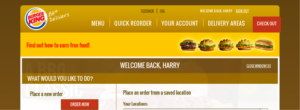The best cell phone I ever used, I never owned
— until I just bought it for $22.27 — Find out WHY 🙂
I was really scared..I was really worried if this was a “good” deal or not.. it was!!
— until I just bought it for $22.27 — Find out WHY 🙂
I was really scared..I was really worried if this was a “good” deal or not.. it was!!
Facebook has 1.2 Billion 2 Billion Active Monthly Users.
Facebook literally is the most perfect marketing system ever created.
But – It doesn’t work the way you think it works – Harry Hawk
Data privacy, online security and tracking should be a concern for all of us. Harry has put forward ideas and concepts for modern marketing that give consumers choice over how they wish to consume content.
When consumers opt for ad sponsored content, media buyers, ad network operators, and publishers should have the data they need to best monetize their content.
Consumers should feel safe that their data isn’t being mishandled or misused.
I promise you that content marketing works but it takes time and effort; critical details need to be thought through. Producing the first piece of content, in the first format that comes to mind is no more likely to work than asking the first person you see to marry you.
Large or small, if you are looking to build awareness and influence for your brand, most experts will tell you that content marketing is crucial if not a critical step. I agree.
As critical as it is would be content marketers often fail to think beyond the first few content types they know. Just because a marketer knows about blogging doesn’t mean it is the right choice. Educational content (for example) is often overlooked.
There are many questions to ask about tone, voice and style, assuming blogging is right for your audience
[Read more…] about Educated Content: Why Content Marketing Works
Real-time marketing doesn’t restore the balance of power to brands, but it does give brands a better footing and platform to define themselves in the dynamic and chaotic world of real-time communications.
Remember, real-time marketing technologies are only now emerging, and they will continue to evolve for years. Some people use the term only as it relates directly to social media and real time engagement. (See: How to Market in Real-Time.)
Dear friends,
July, 2017
The transformation of this site is nearly complete. Hawk Digital Marketing’s home page has been merged into this site. It can be found at:
https://www.talkingabouteverything.com/hawk-digital-marketing/
We have added channels for the sub-topics covered by the Talking About Everything podcast. More will be coming in the months and years ahead. Each of the sub-channels is available as a stand-alone podcast on iTunes and Google Play. The channels will allow folks to subscribe to the precise content they wish e.g., Food Culture vs. Integrated Marketing and Communications.
https://www.talkingabouteverything.com/channels/
Podcast vs. Blog
Nearly all of our posts contain audio, and those are available through our main podcast “Talking About Everything.” We do have a few posts which contain no audio. These prose only posts are listed under the blog category Hawk Digital Marketing.
https://www.talkingabouteverything.com/category/hawk-digital-post/
January, 2017:
This site has been transitioned. This new site is running on WP, and the podcasts themselves are being hosted with Blubrry. The prior vers. of the site was running on Blogger and the podcasts were hosted at LibSyn.
The AMP vers. of the site is largely working. If you are on a mobile device try:

All around the world the Gay community takes to the streets to celebrate and to promote our right to self expression and self pride in the face of intolerance. Every city is different and unique; in the mid 1990’s I attended Tokyo Gay Pride… there were more folks in the parade than watching.

American’s from the United States are often geographically challenged. CDMX or Mexico City, Mexico is the largest city in North America.. and if queerness is distributed equally by population; CDMX has to also be the largest gay community in North America.

Purely as part of my academic research, I have been eating a lot more fast food, checking out limited time only offers and the restaurants’ service.
For breakfast the other day, I ordered fried egg and burger sliders with caramelized onions and no cheese at White Castle. The receipt was correct, but the order had cheese. At McDonalds, I ordered a Sweet Chili Chicken wrap but received a Ranch Chicken Wrap. The receipt was correct, but it took 20 minutes to place and receive my order at a store that was well staffed with only a few in-store customers — apparently employees were focused on the busy drive-thru. Order complexity, wait times, speed, and accuracy are among the many issues the restaurant industry faces.

The whole topic of in-store engagement and alternative payment systems is heating up. Let’s face it — nearly everyone who visits quick serve restaurants has a mobile device on them. These restaurants (and grocery stores) have similar high traffic and low margins and both seek customer loyalty. Of the two, only grocery stores have succeeded with loyalty programs. There is hope that personalized, socialized, and mobile technology will change the game for quick serve restaurants and prove to be a winning tactic.


Online ordering and payment reduce errors, increase transaction speed, and narrow casts notifications (an easy way to tell you an order is ready). Labor-saving efforts normally require consumer and staff education that increases when the change is complex. Apps facilitate labor reduction and eliminate many education requirements while cloaking complexity with a well-mannered user interface. Companies like McDonalds, Burger King, and Subway are investigating these technologies; at Five Guys, consumers can order from the counter, a website, or mobile app.
Mobile payments and ordering will benefit chain owners, but I am rather sure this offers few benefits to the consumer. Mobile ordering is not going to solve the problem of correctly entered orders served incorrectly. Then there is the willingness and time needed to set up a wallet. Up to three times more millennials are embracing mobile payment over Gen X and Boomers, according to at least one report. Will merchants accept universal payment systems? It might be cheaper if each chain has its own payment system. Private wallets lock-in customers, in the same way JC Penny won’t accept a Macy’s charge card.

If I am waiting in a line, I’m holding my phone. If I had a e-wallet on my phone, I would rather use it than put away my phone, find my actual wallet, and fish out my debit card or cash. Not having to put away a phone and then find a physical wallet might be the only consumer benefit. But will consumers embrace mobile wallets? Seventy percent of GenY have not done this yet. Long term, consumer benefits (beyond speed and convenience) might include the ability for parents to pre-approve spending for particular items at particular times and locations, or constrain personal or family member spending to pre-set budgets.
For the restaurants themselves, payment from an application or mobile device opens the door to a more direct and intimate relationship with customers, potentially driving loyalty and retention. If McDonalds, Wendy’s, Five Guys, Subway, and other chains start accepting universal wallets, that could drive setup and create an ecosystem for the benefit of other merchants. Quick-serve restaurants will benefit — if the trend mirrors credit cards — as consumers buy more often, buy larger quantities, or buy more profitable items. Businesses will also benefit if transaction fees are lower, as higher fees would be counter productive. Let’s assume they don’t have to give Google, Amazon, Apple, Sprint, AT&T, or Verizon a cut of the transaction.

With few intrinsic benefits, perhaps merchants will offer discounts and free food as an enticement. Burger King’s online delivery system attempts to do this by building a loyalty program into the online ordering process.The loyalty program and the relationship that comes with it may well be worth the price of admission for merchants and consumers. If restaurants must offer discounts and free food to jumpstart mobile and online ordering, let’s hope it pays off for both parties.
Consumers won’t voluntarily embrace something that gives them little or no benefit. How much free food and coupons will habituate consumers to this new experience? Chipotle is adding games. Is that an incentive or a distraction? Only time will tell.
